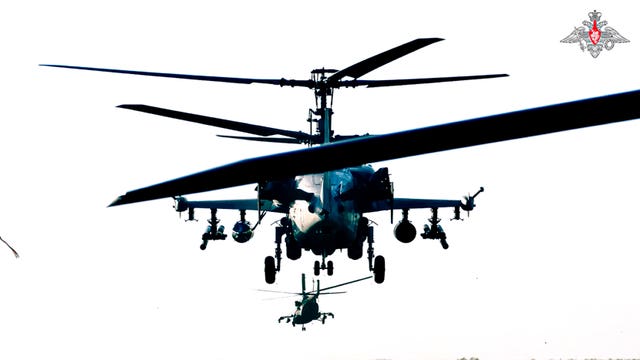A swift Ukrainian incursion into Russia’s Kursk region is the largest such cross-border raid by Kyiv’s forces in the nearly two-and-a-half year war, exposing Russia’s vulnerabilities and dealing a painful blow to the Kremlin.
The surprise foray has prompted tens of thousands of civilians to flee the region as the Russian military struggles to repel the attack.
For Ukraine, the cross-border raid offers a much-needed boost to public morale at a time when the country’s undermanned and under-gunned forces have faced relentless Russian attacks along the more than 1,000 kilometre (620-mile) front line.
Here is a look at the Ukrainian raid and its implications.
– How did the Ukrainian attack unfold?

Unlike previous raids conducted by small groups of Russian volunteers fighting alongside Ukrainian forces, the incursion into the Kursk region reportedly involved units from several battle-hardened Ukrainian army brigades.
Russian military bloggers reported that Ukrainian mobile groups comprised of several armoured vehicles each quickly drove dozens of kilometres into Russian territory, bypassing Russian fortifications and sowing panic across the region.
The Institute for the Study of War, a Washington-based think-tank, said Ukrainian forces have managed to push up to 35 kilometres (20 miles) deep into the region. “Ukrainian forces appear to be able to use these small armoured groups to conduct assaults past the engagement line due to the low density of Russian personnel in the border areas,” it said in an analysis of the raid.
The Ukrainian forces have widely used drones to strike Russian military vehicles and deployed electronic warfare assets to suppress Russian drones and derail military communications.
While small Ukrainian mobile groups roamed the region without trying to consolidate control, other troops have reportedly started digging in the western part of the town of Sudzha about 10 kilometres (six miles) from the border and in some other areas.
– How has the Russian military responded?

The manpower shortage prompted Russian military command to initially rely on warplanes and helicopter gunships to try to stem the Ukrainian attack. At least one Russian helicopter was downed and another one was damaged by the advancing Ukrainian forces, according to Russian military bloggers.
Russian reinforcements, including elite special forces units and hardened veterans of the Wagner military contractor, later started to arrive in the Kursk region, but they have so far failed to dislodge the Ukrainian forces from Sudzha and other areas near the border.
Some of the newly arriving troops lacked combat skills and suffered casualties. In one example, a convoy of military trucks carelessly stopped on the roadside near the combat area and was pummelled by Ukrainian fire.
The Russian Defence Ministry declared on Friday that Ukraine lost 945 soldiers in four days of fighting. The claim could not be independently verified. The ministry did not offer any data on Russian casualties.
– What did Ukrainian authorities say about the incursion?
Officials in Kyiv have refrained from comments on the cross-border raid, but President Volodymyr Zelensky hailed the armed forces for their “actions to push the war out into the aggressor’s territory”.
“Ukraine is proving that it really knows how to restore justice and guarantees exactly the kind of pressure that is needed – pressure on the aggressor,” he said in a nightly video address.
Zelensky adviser Mykhailo Podolyak said on Thursday that cross-border attacks will cause Russia to “start to realise that the war is slowly creeping inside of Russian territory”. He also suggested such an operation would improve Kyiv’s hand in any future negotiations with Moscow.
“When will it be possible to conduct a negotiation process in a way that we can push them or get something from them? Only when the war is not going on according to their scenarios,” he said.
– What did the Kremlin say?

Russian authorities said at least five civilians, including two ambulance workers, have been killed in the Ukrainian attack on the Kursk region and nearly 70 others have been wounded. More than 76,000 people have been evacuated from the areas engulfed by fighting, officials said.
Dmitry Medvedev, deputy head of the Putin-chaired Security Council, said the Ukrainian raid emphasised the need for Moscow to expand its war goals to capturing more of the Ukrainian territory, including the capital Kyiv, the Black Sea port of Odesa and other major cities.
Russia has announced a federal emergency in the Kursk region and declared a counterterrorism operation in the area and neighbouring Belgorod and Bryansk regions, giving local authorities more powers to quickly co-ordinate an emergency response and tighten security.
Russian state propaganda focused on the Kremlin’s efforts to provide assistance to displaced residents while playing down the military’s unpreparedness for the attack.
– What are Ukraine’s goals and how could the situation unfold?

Coming at a time when Kyiv’s forces are struggling to stem the Russian advances in the east, the swift cross-border raid shows Ukraine’s ability to seize the initiative. It has also dealt a blow to the Kremlin, highlighting its failure to protect the country’s territory and shattering Mr Putin’s narrative that Russia has remained largely unaffected by the hostilities.
But despite the initial successes, the foray into Russia could cause attrition in some of Ukraine’s most capable units and leave troops in Donetsk without vital reinforcements.
Trying to establish a lasting presence in the Kursk region could be challenging for the Ukrainian forces, whose supply lines would be vulnerable to Russian fire.
Military analysts say it is still unclear what Ukraine’s operational goals are and how many troops it has committed in the Kursk raid.
Michael Kofman, a military analyst with the Carnegie Endowment, said in a comment on social media platform X that “a fair bit depends on what Ukraine has available in reserve to throw into the operation, and how quickly Russian Federation organizes to counter”.






